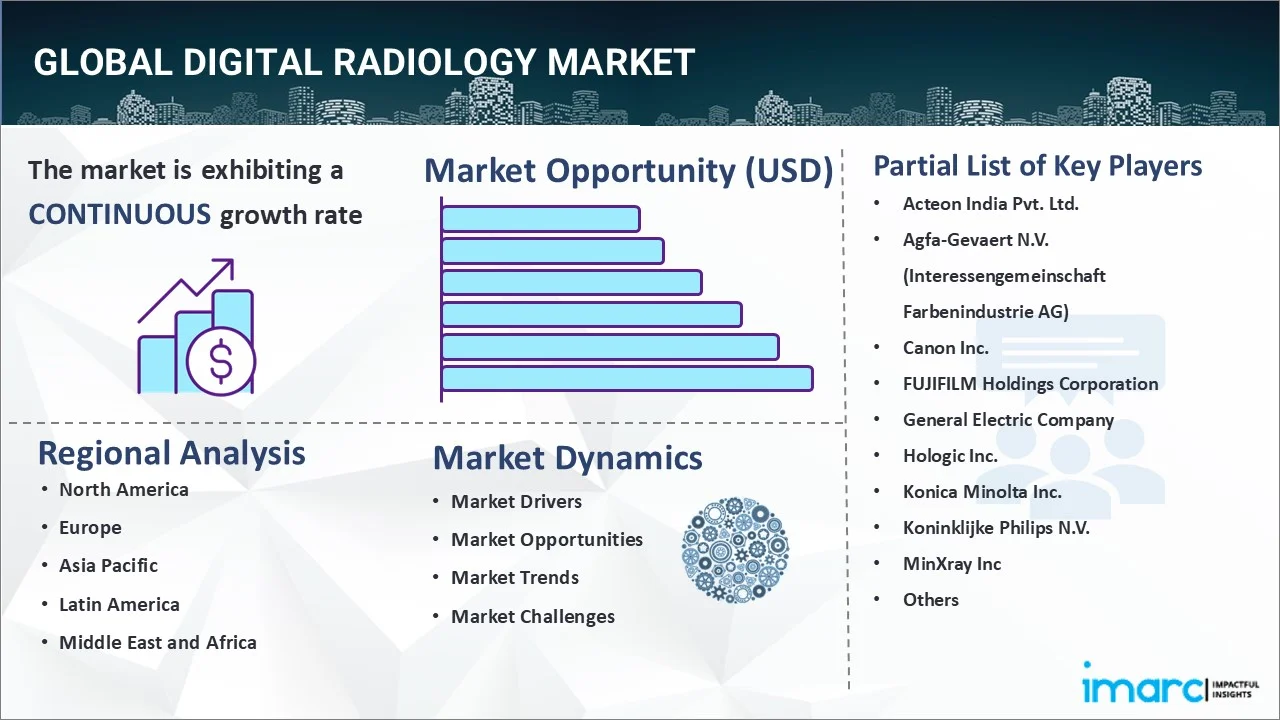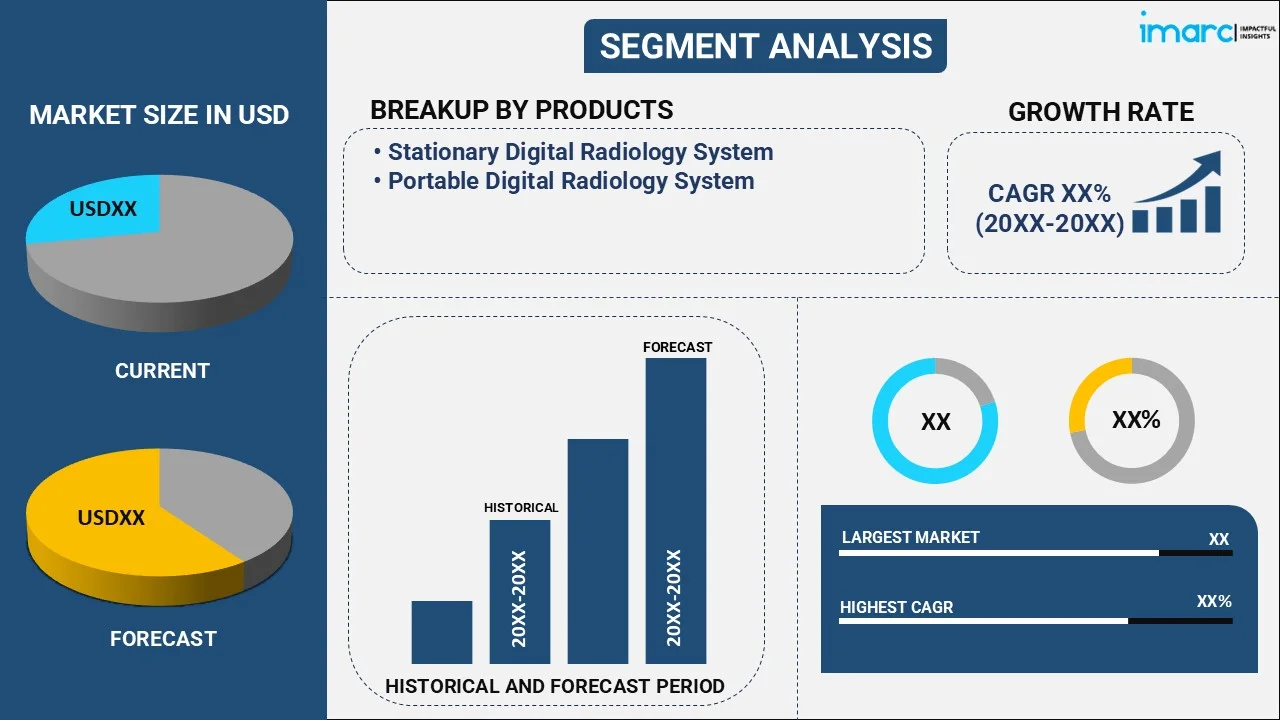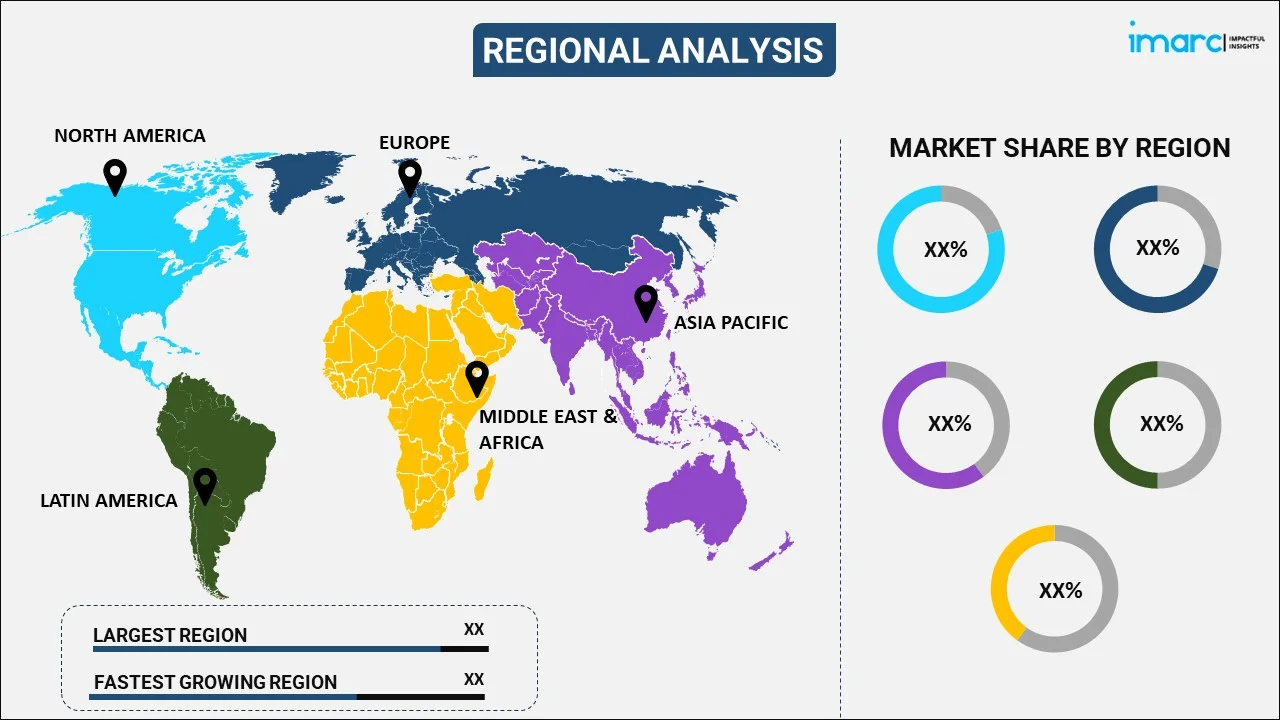
Digital Radiology Market Report by Product (Stationary Digital Radiology System, Portable Digital Radiology System), Application (Cardiovascular Imaging, Chest Imaging, Dental Imaging, Digital Mammography, Orthopedic Imaging, and Others), Technology (Direct Digital Radiology, Computed Digital Radiology), End User (Diagnostic Clinics, Hospitals, and Others), and Region 2025-2033
Market Overview:
The global digital radiology market size reached USD 3.3 Billion in 2024. Looking forward, IMARC Group expects the market to reach USD 5.0 Billion by 2033, exhibiting a growth rate (CAGR) of 4.23% during 2025-2033. The growing demand for improved clinical workflow to reduce patient wait times, rising prevalence of various chronic diseases, and increasing integration of advanced healthcare systems for enhanced patient care are some of the major factors propelling the market.
|
Report Attribute
|
Key Statistics
|
|---|---|
|
Base Year
|
2024 |
|
Forecast Years
|
2025-2033
|
|
Historical Years
|
2019-2024
|
| Market Size in 2024 | USD 3.3 Billion |
| Market Forecast in 2033 | USD 5.0 Billion |
| Market Growth Rate (2025-2033) | 4.23% |
Digital radiology, also known as digital radiography, is a medical imaging technology that comprises the use of digital sensors to capture X-ray images of the human body and eliminate the need for traditional film and chemical processing. It assists in offering faster image acquisition, immediate availability of images, enhanced images for improved visualization, and lower radiation exposure for patients as compared to traditional radiography. As it aids in improving the efficiency, accuracy, and convenience of medical imaging, the demand for digital radiology is rising across the globe.

At present, the increasing adoption of digital radiology among healthcare professionals for more informed decision-making is bolstering the growth of the market. Besides this, the growing demand for enhanced patient care, along with the increasing popularity of patient-centric approaches in healthcare facilities around the world, is offering a positive market outlook. In line with this, the rising adoption of radiology systems that eliminate the need for film and chemical processing and reduce associated costs is propelling the growth of the market. Apart from this, the increasing preferences for telemedicine and remote consultations among individuals is contributing to the growth of the market. Furthermore, favorable government initiatives to improve patient care are strengthening the growth of the market. Moreover, advancements in image processing software, such as artificial intelligence (AI) and machine learning (ML) algorithms, to enhance diagnostic accuracy are supporting the growth of the market.
Digital Radiology Market Trends/Drivers:
Growing demand for improved clinical workflow
The growing demand for improved clinical workflow that reduces the burden on healthcare professionals is supporting the growth of the market. Moreover, digital radiology provides faster image acquisition that enables healthcare professionals to quickly capture and assess images and reduce patient wait times. In addition, the superior image quality of digital radiographs allows for clearer visualization of anatomical structures that assist in enhancing diagnostic accuracy. Apart from this, digital systems enable the post-processing of images, such as zooming, enhancing contrast, and adjusting brightness, which facilitate improved interpretation by radiologists. Furthermore, the rising adoption of this radiology, as it allows healthcare providers to prioritize patient safety and efficient diagnostics, is bolstering the growth of the market.
Increasing integration of advanced healthcare systems
The integration of digital radiology with picture archiving and communication systems (PACS) and electronic health records (EHR) is contributing to the growth of the market. In addition, it allows images to be easily stored, retrieved, and shared within healthcare institutions through PACS and eliminates the need for physical film storage while enhancing data accessibility. Apart from this, integration with EHR systems enables seamless incorporation of radiological findings into medical records of patients and facilitates comprehensive and collaborative patient care. This integration streamlines communication between healthcare professionals and improves decision-making by providing a holistic view of patient health information. There is a rise in the demand to enhance efficiency and patient care coordination.
Rising prevalence of various chronic diseases
The increasing prevalence of several chronic diseases among the masses across the globe is contributing to the growth of the market. In line with this, there is a rise in the demand for advanced diagnostic tools that can efficiently provide accurate results. People are increasingly suffering from different chronic conditions due to genetics, improper balanced diet, and lack of physical exercise. Besides this, digital radiology has three-dimensional (3D) imaging and multi-planar reconstruction that aid in diagnosing complex cases and guiding interventions. There is an increase in the demand for accurate and timely diagnosis for effective disease management and treatment planning. Furthermore, the incorporation of advanced technologies allows radiologists to identify abnormalities and patterns in an accurate and time saving manner.
Digital Radiology Industry Segmentation:
IMARC Group provides an analysis of the key trends in each segment of the global digital radiology market report, along with forecasts at the global, regional and country levels for 2025-2033. Our report has categorized the market based on product, application, technology, and end user.
Breakup by Product:

- Stationary Digital Radiology System
- Portable Digital Radiology System
The report has provided a detailed breakup and analysis of the market based on the product. This includes stationary digital radiology system and portable digital radiology system.
Stationary digital radiology system refers to fixed imaging equipment installed within healthcare facilities. These systems are commonly found in hospitals, clinics, and diagnostic centers. They offer a wide range of imaging capabilities and are designed to provide high-quality diagnostic images for a variety of medical applications. Stationary systems are often used for routine radiography, specialized imaging procedures, and complex diagnostic tasks. They offer advanced features, such as multi-detector configurations and specialized imaging modes, which makes them suitable for a broad spectrum of clinical needs.
Portable digital radiology systems, also known as mobile X-ray units, are designed for flexibility and mobility. These systems are particularly useful in scenarios where patients cannot be moved easily, such as in intensive care units, emergency rooms, or remote locations. They allow healthcare providers to bring imaging technology near to patients that improves patient comfort and reduces the need for patient transport.
Breakup by Application:
- Cardiovascular Imaging
- Chest Imaging
- Dental Imaging
- Digital Mammography
- Orthopedic Imaging
- Others
The report has provided a detailed breakup and analysis of the market based on the application. This includes cardiovascular imaging, chest imaging, dental imaging, digital mammography, orthopedic imaging, and others.
Cardiovascular imaging assesses the heart and blood vessels and plays a crucial role in diagnosing and monitoring various cardiovascular conditions such as heart disease, vascular abnormalities, and cardiac anomalies. It enables the visualization of the structure, size, and blood flow patterns of the heart and aids in the detection of issues like coronary artery disease, valve disorders, and congenital heart defects.
Chest imaging focuses on capturing images of the chest area, such as lungs, ribs, and surrounding structures. It is commonly used to diagnose respiratory conditions such as pneumonia, lung cancer, and chronic obstructive pulmonary disease (COPD). It offers detailed images of the chest that allow healthcare professionals to identify abnormalities, assess lung health, and guide treatment decisions effectively.
Dental imaging comprises various techniques, including intraoral and extraoral imaging, to capture detailed images of the teeth, jaws, and surrounding oral structures. It provides high-resolution images with minimal radiation exposure, which makes it an essential tool for diagnosing dental issues like cavities, periodontal disease, and dental anomalies.
Breakup by Technology:
- Direct Digital Radiology
- Computed Digital Radiology
Direct digital radiology accounts for the majority of the market share
The report has provided a detailed breakup and analysis of the market based on the technology. This includes direct digital radiology and computed digital radiology. According to the report, direct digital radiology represented the largest segment.
Direct digital radiology is a technique that directly captures X-ray images using digital detectors and eliminates the need for traditional film or image conversion processes. In these systems, X-ray photons are detected by a digital sensor, which converts the radiation into electronic signals. These signals are then processed and transformed into high-resolution digital images that can be viewed instantly on computer screens. In addition, it provides rapid image acquisition, immediate availability of images for diagnosis, and can manipulate images for enhanced visualization.
Breakup by End User:
- Diagnostic Clinics
- Hospitals
- Others
Diagnostic clinics represent the largest market share
The report has provided a detailed breakup and analysis of the market based on the end-user. This includes diagnostic clinics, hospitals, and others. According to the report, diagnostic clinics represented the largest segment.
Diagnostic clinics are healthcare facilities that provide a wide range of diagnostic services. These clinics play a vital role in patient care by offering timely and accurate diagnoses for various medical conditions. Diagnostic clinics utilize advanced imaging technology to capture high-quality images of the internal structures of the body and aid in the identification of diseases, injuries, and abnormalities. They provide reduced waiting times, specialized expertise, and focused services, which makes them a preferred choice for individuals seeking prompt and accurate diagnostics.
Breakup by Region:

- North America
- United States
- Canada
- Asia Pacific
- China
- Japan
- India
- South Korea
- Australia
- Indonesia
- Others
- Europe
- Germany
- France
- United Kingdom
- Italy
- Spain
- Russia
- Others
- Latin America
- Brazil
- Mexico
- Others
- Middle East and Africa
North America exhibits a clear dominance, accounting for the largest digital radiology market share
The market research report has also provided a comprehensive analysis of all the major regional markets, which include North America (the United States and Canada); Asia Pacific (China, Japan, India, South Korea, Australia, Indonesia, and others); Europe (Germany, France, the United Kingdom, Italy, Spain, Russia, and others); Latin America (Brazil, Mexico, and others); and the Middle East and Africa. According to the report, North America accounted for the largest market share.
North America held the biggest market share due to the increasing focus on medical innovation. Moreover, the growing demand for accurate and efficient diagnostic tools due to the prevalence of severe diseases is offering a positive market outlook. Apart from this, the presence of key manufacturers, research institutions, and healthcare facilities is contributing to the growth of the market. In addition, favorable regulatory frameworks are propelling the growth of the market in the North America region.
Competitive Landscape:
Key players are investing in research and development (R&D) activities to enhance the technological capabilities of these systems. This includes improvements in image resolution, image processing algorithms, and integration with advanced software solutions, such as artificial intelligence (AI) and machine learning (ML), to assist radiologists in accurate diagnoses. In addition, companies are ensuring regulatory compliance and maintaining high quality standards by investing in certifications and adhering to relevant regulations to provide safe and effective solutions. Apart from this, companies are providing training programs and educational resources for healthcare professionals to effectively use their radiology systems. This ensures that users can maximize the benefits of the technology and deliver accurate diagnoses.
The report has provided a comprehensive analysis of the competitive landscape in the market. Detailed profiles of all major companies have also been provided. Some of the key players in the market include:
- Acteon India Pvt. Ltd.
- Agfa-Gevaert N.V. (Interessengemeinschaft Farbenindustrie AG)
- Canon Inc.
- FUJIFILM Holdings Corporation
- General Electric Company
- Hologic Inc.
- Konica Minolta Inc.
- Koninklijke Philips N.V.
- MinXray Inc
- Shimadzu Corporation
- Siemens Healthineers AG (Siemens AG)
- Swissray International Inc. (Swissray Global Healthcare)
Recent Developments:
- In May 2021, Fujifilm India Pvt. Ltd. introduced X-ray solutions augmented with qXR, Qure.ai’s computed aided radiology software application that is designed with deep-learning Artificial Intelligence (AI) technology.
- In 2020, Canon Medical launched OMNERA® 500A Digital Radiography System that offers heightened productivity for fast-paced imaging departments so that technologists can focus on their patients.
- In September 2021, GE Healthcare introduced the AMX Navigate, a new portable, digital X-ray system that is designed with a first-of-its-kind power-assisted Free Motion telescoping column that aims to reduce lift force and decrease technologist injury.
Digital Radiology Market Report Scope:
| Report Features | Details |
|---|---|
| Base Year of the Analysis | 2024 |
| Historical Period | 2019-2024 |
| Forecast Period | 2025-2033 |
| Units | Billion USD |
| Scope of the Report | Exploration of Historical Trends and Market Outlook, Industry Catalysts and Challenges, Segment-Wise Historical and Predictive Market Assessment:
|
| Products Covered | Stationary Digital Radiology System, Portable Digital Radiology System |
| Applications Covered | Cardiovascular Imaging, Chest Imaging, Dental Imaging, Digital Mammography, Orthopedic Imaging, Others |
| Technologies Covered | Direct Digital Radiology, Computed Digital Radiology |
| End Users Covered | Diagnostic Clinics, Hospitals, Others |
| Regions Covered | Asia Pacific, Europe, North America, Latin America, Middle East and Africa |
| Countries Covered | United States, Canada, Germany, France, United Kingdom, Italy, Spain, Russia, China, Japan, India, South Korea, Australia, Indonesia, Brazil, Mexico |
| Companies Covered | Acteon India Pvt. Ltd., Agfa-Gevaert N.V. (Interessengemeinschaft Farbenindustrie AG), Canon Inc., FUJIFILM Holdings Corporation, General Electric Company, Hologic Inc., Konica Minolta Inc., Koninklijke Philips N.V., MinXray Inc, Shimadzu Corporation, Siemens Healthineers AG (Siemens AG), Swissray International Inc. (Swissray Global Healthcare), etc. |
| Customization Scope | 10% Free Customization |
| Post-Sale Analyst Support | 10-12 Weeks |
| Delivery Format | PDF and Excel through Email (We can also provide the editable version of the report in PPT/Word format on special request) |
Key Benefits for Stakeholders:
- IMARC’s industry report offers a comprehensive quantitative analysis of various market segments, historical and current market trends, market forecasts, and dynamics of the digital radiology market from 2019-2033.
- The research report study provides the latest information on the market drivers, challenges, and opportunities in the global digital radiology market.
- The study maps the leading, as well as the fastest-growing, regional markets. It further enables stakeholders to identify the key country-level markets within each region.
- Porter's five forces analysis assist stakeholders in assessing the impact of new entrants, competitive rivalry, supplier power, buyer power, and the threat of substitution. It helps stakeholders to analyze the level of competition within the digital radiology industry and its attractiveness.
- Competitive landscape allows stakeholders to understand their competitive environment and provides an insight into the current positions of key players in the market.
Key Questions Answered in This Report
The global digital radiology market was valued at USD 3.3 Billion in 2024.
We expect the global digital radiology market to exhibit a CAGR of 4.23% during 2025-2033.
The increasing demand for digital radiology to quickly capture and assess images and reduce patient wait times, along with the escalating integration of AI and ML algorithms with digital radiology to enhance diagnostic accuracy, is primarily driving the global digital radiology market.
The sudden outbreak of the COVID-19 pandemic has led to the rising adoption of digital radiology technology to capture the X-ray images, which are further utilized in detecting the coronavirus-infection in the human body.
Based on the technology, the global digital radiology market has been divided into direct digital radiology and computed digital radiology, where direct digital radiology currently holds the largest market share.
Based on the end user, the global digital radiology market can be bifurcated into diagnostic clinics, hospitals, and others. Currently, diagnostic clinics exhibit a clear dominance in the market.
On a regional level, the market has been classified into North America, Asia-Pacific, Europe, Latin America, and Middle East and Africa, where North America currently dominates the global market.
Some of the major players in the global digital radiology market include Acteon India Pvt. Ltd., Agfa-Gevaert N.V. (Interessengemeinschaft Farbenindustrie AG), Canon Inc., FUJIFILM Holdings Corporation, General Electric Company, Hologic Inc., Konica Minolta Inc., Koninklijke Philips N.V., MinXray Inc, Shimadzu Corporation, Siemens Healthineers AG (Siemens AG), and Swissray International Inc. (Swissray Global Healthcare).
Need more help?
- Speak to our experienced analysts for insights on the current market scenarios.
- Include additional segments and countries to customize the report as per your requirement.
- Gain an unparalleled competitive advantage in your domain by understanding how to utilize the report and positively impacting your operations and revenue.
- For further assistance, please connect with our analysts.
 Inquire Before Buying
Inquire Before Buying
 Speak to an Analyst
Speak to an Analyst
 Request Brochure
Request Brochure
 Request Customization
Request Customization




.webp)




.webp)












